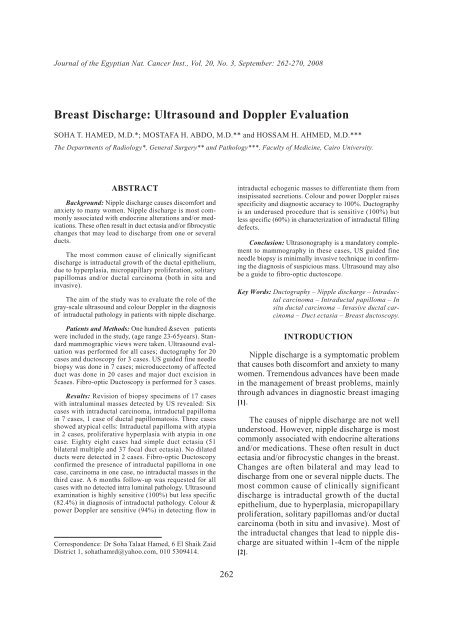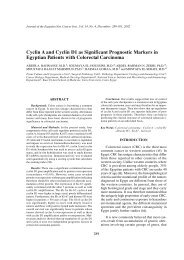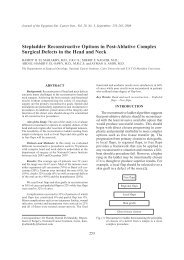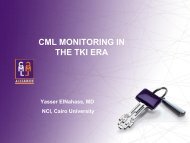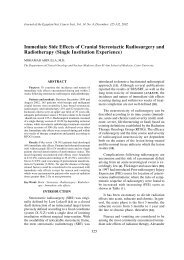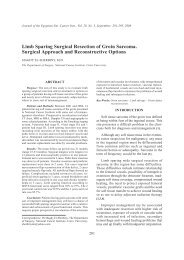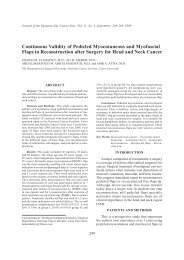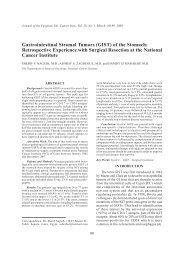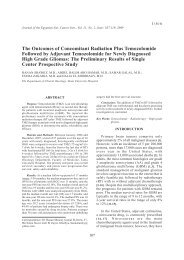Breast Discharge: Ultrasound and Doppler Evaluation - NCI
Breast Discharge: Ultrasound and Doppler Evaluation - NCI
Breast Discharge: Ultrasound and Doppler Evaluation - NCI
Create successful ePaper yourself
Turn your PDF publications into a flip-book with our unique Google optimized e-Paper software.
Journal of the Egyptian Nat. Cancer Inst., Vol. 20, No. 3, September: 262-270, 2008<br />
<strong>Breast</strong> <strong>Discharge</strong>: <strong>Ultrasound</strong> <strong>and</strong> <strong>Doppler</strong> <strong>Evaluation</strong><br />
SOHA T. HAMED, M.D.*; MOSTAFA H. ABDO, M.D.** <strong>and</strong> HOSSAM H. AHMED, M.D.***<br />
The Departments of Radiology*, General Surgery** <strong>and</strong> Pathology***, Faculty of Medicine, Cairo University.<br />
ABSTRACT<br />
Background: Nipple discharge causes discomfort <strong>and</strong><br />
anxiety to many women. Nipple discharge is most commonly<br />
associated with endocrine alterations <strong>and</strong>/or medications.<br />
These often result in duct ectasia <strong>and</strong>/or fibrocystic<br />
changes that may lead to discharge from one or several<br />
ducts.<br />
The most common cause of clinically significant<br />
discharge is intraductal growth of the ductal epithelium,<br />
due to hyperplasia, micropapillary proliferation, solitary<br />
papillomas <strong>and</strong>/or ductal carcinoma (both in situ <strong>and</strong><br />
invasive).<br />
The aim of the study was to evaluate the role of the<br />
gray-scale ultrasound <strong>and</strong> colour <strong>Doppler</strong> in the diagnosis<br />
of intraductal pathology in patients with nipple discharge.<br />
Patients <strong>and</strong> Methods: One hundred &seven patients<br />
were included in the study, (age range 23-65years). St<strong>and</strong>ard<br />
mammographic views were taken. <strong>Ultrasound</strong> evaluation<br />
was performed for all cases; ductography for 20<br />
cases <strong>and</strong> ductoscopy for 3 cases. US guided fine needle<br />
biopsy was done in 7 cases; microducectomy of affected<br />
duct was done in 20 cases <strong>and</strong> major duct excision in<br />
5cases. Fibro-optic Ductoscopy is performed for 3 cases.<br />
Results: Revision of biopsy specimens of 17 cases<br />
with intraluminal masses detected by US revealed: Six<br />
cases with intraductal carcinoma, intraductal papilloma<br />
in 7 cases, 1 case of ductal papillomatosis. Three cases<br />
showed atypical cells: Intraductal papilloma with atypia<br />
in 2 cases, proliferative hyperplasia with atypia in one<br />
case. Eighty eight cases had simple duct ectasia (51<br />
bilateral multiple <strong>and</strong> 37 focal duct ectasia). No dilated<br />
ducts were detected in 2 cases. Fibro-optic Ductoscopy<br />
confirmed the presence of intraductal papilloma in one<br />
case, carcinoma in one case, no intraductal masses in the<br />
third case. A 6 months follow-up was requested for all<br />
cases with no detected intra luminal pathology. <strong>Ultrasound</strong><br />
examination is highly sensitive (100%) but less specific<br />
(82.4%) in diagnosis of intraductal pathology. Colour &<br />
power <strong>Doppler</strong> are sensitive (94%) in detecting flow in<br />
Correspondence: Dr Soha Talaat Hamed, 6 El Shaik Zaid<br />
District 1, sohathamrd@yahoo.com, 010 5309414.<br />
intraductal echogenic masses to differentiate them from<br />
insipissated secretions. Colour <strong>and</strong> power <strong>Doppler</strong> raises<br />
specificity <strong>and</strong> diagnostic accuracy to 100%. Ductography<br />
is an underused procedure that is sensitive (100%) but<br />
less specific (60%) in characterization of intraductal filling<br />
defects.<br />
Conclusion: Ultrasonography is a m<strong>and</strong>atory complement<br />
to mammography in these cases, US guided fine<br />
needle biopsy is minimally invasive technique in confirming<br />
the diagnosis of suspicious mass. <strong>Ultrasound</strong> may also<br />
be a guide to fibro-optic ductoscope.<br />
Key Words: Ductography – Nipple discharge – Intraductal<br />
carcinoma – Intraductal papilloma – In<br />
situ ductal carcinoma – Invasive ductal carcinoma<br />
– Duct ectasia – <strong>Breast</strong> ductoscopy.<br />
INTRODUCTION<br />
Nipple discharge is a symptomatic problem<br />
that causes both discomfort <strong>and</strong> anxiety to many<br />
women. Tremendous advances have been made<br />
in the management of breast problems, mainly<br />
through advances in diagnostic breast imaging<br />
[1].<br />
The causes of nipple discharge are not well<br />
understood. However, nipple discharge is most<br />
commonly associated with endocrine alterations<br />
<strong>and</strong>/or medications. These often result in duct<br />
ectasia <strong>and</strong>/or fibrocystic changes in the breast.<br />
Changes are often bilateral <strong>and</strong> may lead to<br />
discharge from one or several nipple ducts. The<br />
most common cause of clinically significant<br />
discharge is intraductal growth of the ductal<br />
epithelium, due to hyperplasia, micropapillary<br />
proliferation, solitary papillomas <strong>and</strong>/or ductal<br />
carcinoma (both in situ <strong>and</strong> invasive). Most of<br />
the intraductal changes that lead to nipple discharge<br />
are situated within 1-4cm of the nipple<br />
[2].<br />
262
<strong>Breast</strong> <strong>Discharge</strong>: <strong>Ultrasound</strong> & <strong>Doppler</strong> <strong>Evaluation</strong><br />
<strong>Ultrasound</strong> is an indispensable complementary<br />
diagnostic tool in the investigation of breast<br />
abnormalities. <strong>Ultrasound</strong> is not typically used<br />
unless the nipple discharge is accompanied by<br />
a palpable mass or a positive mammographic<br />
finding. <strong>Ultrasound</strong> may be useful in presurgical<br />
localization if galactography reveals a dilated<br />
duct larger than a few millimeters in width.<br />
Modern high-resolution <strong>Ultrasound</strong> techniques<br />
are becoming more sensitive for the visualization<br />
of intraductal changes. Tiny solitary papillomas<br />
can sometimes be visualized by using this sophisticated<br />
technology [3].<br />
The aim of the study was to evaluate the<br />
role of the gray-scale ultrasound <strong>and</strong> colour<br />
<strong>Doppler</strong> in the diagnosis of intraductal pathology<br />
in patients with nipple discharge.<br />
PATIENTS AND METHODS<br />
One hundred <strong>and</strong> seven patients were included<br />
in the study, their mean age 42±13<br />
years <strong>and</strong> their ages ranged between 23 <strong>and</strong><br />
65 years. Mammograms were performed for<br />
all cases using "Siemens Mammomat Mammography<br />
Unit". Cranio-caudal, mediolateral<br />
<strong>and</strong> oblique views were performed for both<br />
breasts. A range of 25-28 KVP <strong>and</strong> 30-60 MAS<br />
were used. Mammograms were fully inspected<br />
to assess the parenchyma density <strong>and</strong> pattern,<br />
the presence or absence of associated mass<br />
lesions <strong>and</strong> calcifications <strong>and</strong> each was analyzed<br />
individually. The skin thickness, the<br />
condition of nipple areola complex <strong>and</strong> associated<br />
lymphadenopathy were also reported.<br />
In addition to mammography, Ductography<br />
was performed for 20 cases. The nipple was<br />
inspected to identify the orifice of secretion,<br />
After the nipple is sterilized, a ductography<br />
cannula (i.e., a needle with a blunt end) was<br />
gently inserted into the secreting orifice; Approximately<br />
0.2-0.8mL of water-soluble contrast<br />
material is slowly injected by using a 1-<br />
or 3-mL syringe.<br />
<strong>Ultrasound</strong> was performed for all patients<br />
with an Ultramark Philips HDI 5000, Siemens<br />
Sonoline Elegra, voluson 730 machines using<br />
a 7-10MHz linear transducer. The region to be<br />
examined extends from the clavicle above to<br />
the infra-mammary fold below <strong>and</strong> from the<br />
sternum medially to the mid-axillary line laterally.<br />
The axilla <strong>and</strong> supraclavicular regions<br />
263<br />
were also carefully scanned for lymph node<br />
enlargement. A special technique was applied<br />
to examine the retroareolar region by applying<br />
excessive gel on the nipple with gentle pressure<br />
for better visualization of the retroareolar ducts.<br />
The dilated duct was traced throughout its<br />
whole length. Whenever any intraductal lesion<br />
is seen, we should calculate how far it is from<br />
the nipple. This should be followed by 3D<br />
application which allows better lesion delineation<br />
<strong>and</strong> Color <strong>and</strong> power <strong>Doppler</strong> evaluation<br />
to characterize lesion vascularity <strong>Ultrasound</strong><br />
guided fine needle biopsy was performed for<br />
7 cases.<br />
In three cases ductoscopy was performed:<br />
Short term anesthetic was administered, the<br />
nipple was scrubbed <strong>and</strong> rapped; the breast was<br />
deeply massaged from periphery to the center,<br />
as if expressing milk at lactation. The target<br />
duct (fluid-yielding duct) was identified by<br />
manual compression of the individual lactiferous<br />
sinuses. The duct was dilated using the dilators<br />
of lactiferous duct then the ductoscope was<br />
inserted (Fig. 1).<br />
Criteria of lesion assessment:<br />
• Intraductal papillomas: Are mostly oval in<br />
shape, hypo to isoechoic in echopattern, with<br />
smooth margins. A vascular stalk or minimal<br />
peripheral vascularity is usually identified on<br />
<strong>Doppler</strong> application.<br />
• Intraductal papilloma with atypia: Showed<br />
higher vascularity than papillomas. The vessels<br />
are arranged in haphazard distribution.<br />
• Malignant intraductal lesions: Appeared less<br />
uniform with corresponding malignant microcalcification<br />
seen on mammography films.<br />
On colour <strong>Doppler</strong>, malignant lesion showed<br />
higher vascularity, non tapering r<strong>and</strong>omly<br />
dispersed vessels except in small mass lesions.<br />
• Simple duct ectasia: Appeared on mammography<br />
as tubular or diffuse retroareolar increased<br />
density. On ultrasound they appeared<br />
as dilated thin walled ducts (caliber >3mm),<br />
some showed mobile echogenic secretions<br />
that are not adherent to the duct walls, others<br />
revealed inspissated ball like echogenic secretions.<br />
No colour was detected on <strong>Doppler</strong><br />
application.
264<br />
RESULTS<br />
One hundred <strong>and</strong> seven patients, their mean<br />
age 42±13 years <strong>and</strong> their ages ranged between<br />
23 <strong>and</strong> 65 years, presenting either by uniorifical<br />
breast discharge (54 cases) or multi orifice<br />
discharge (one of them with bloody or serosanguous<br />
discharge) (53 cases) (Table 1). Duct<br />
ectasia was the predominant pathology, identified<br />
in 88 cases, their ages range 23-53 years,<br />
with mean age 33.8±11.6 years. While intraductal<br />
mass lesions were identified in only 17<br />
cases, their ages ranging between 27-65 years,<br />
with mean age: 45±12 years. Two cases were<br />
normal.<br />
<strong>Ultrasound</strong> proved to have 100% <strong>and</strong> 82.4%<br />
sensitivity <strong>and</strong> specificity in differentiating<br />
intraductal mass from non mass lesions, namely<br />
inspissated secretions <strong>and</strong> in identifying the<br />
benign or malignant nature of these masses.<br />
Colour <strong>and</strong> power <strong>Doppler</strong> raises specificity<br />
<strong>and</strong> diagnostic accuracy to 100%.<br />
The mean size of papillomas was (8.7±<br />
4.3mm). They lied within 3.2±2.1cm from the<br />
nipple. They all fulfilled the above described<br />
criteria with the exception of two papillomas<br />
with rather irregular outline (Fig. 2). A vascular<br />
stalk could be identified in 4 cases <strong>and</strong> minimal<br />
peripheral vascularity in 3 cases (Fig. 3), Ductoscopy,<br />
performed for 1 case, confirmed the<br />
site <strong>and</strong> size of the ultrasound detected papilloma<br />
(Fig. 4). 3D US was performed confirming the<br />
intraductal location of a lesion (Fig. 5).<br />
The intraductal papillomas showing atypia<br />
measured 5 <strong>and</strong> 11mm, being located between<br />
12 <strong>and</strong> 27mm from the nipple respectively. They<br />
showed higher vascularity than papillomas, the<br />
vessels are arranged in haphazard distribution<br />
(Fig. 6). The case proved to be ductal hyperplasia<br />
with atypia, was discovered during annual<br />
follow-up for fibrocystic breast changes, an<br />
intraductal mass 5mm is seen 27mm from the<br />
nipple (Fig. 7).<br />
<strong>Ultrasound</strong> was complementary to mammography<br />
in identifying malignant intraductal lesions,<br />
one case proved to be invasive ductal<br />
carcinoma, on mammography it was reported<br />
as BIRADS 3, on ultrasound an intraductal mass<br />
with wall irregularity was seen, microcalcification<br />
are seen within the mass but obscured on<br />
Soha T. Hamed, et al.<br />
mammogram by lobulated dilated duct (Fig. 8).<br />
Other masses were ranging in size 4-14mm, no<br />
definite ductal dilatation was seen in two of<br />
them. On colour <strong>Doppler</strong>, malignant lesion<br />
showed higher vascularity, non tapering r<strong>and</strong>omly<br />
dispersed vessels except in small 4mm<br />
mass.<br />
Simple duct ectasia was identified in 88<br />
cases according to the above described criteria.<br />
Mammography showed tubular retroareolar<br />
density in 8 cases, in the rest of cases, there<br />
was just an increase in retroareolar density; By<br />
US In 51 cases, bilateral dilated thin walled<br />
ducts are ranging in caliber from 3-8mm, some<br />
of the ducts showed Intra-ductal mobile, non<br />
adherent movable echogenic secretions were<br />
sometimes identified. In two cases, echogenic<br />
ball like lesions were identified resembling<br />
intraductal pappilomas, yet, they were non<br />
adherent to the wall <strong>and</strong> no colour flow could<br />
be detected on <strong>Doppler</strong> application (Fig. 9).<br />
The ducts were completely normal on both<br />
ultrasound <strong>and</strong> galactography in two cases.<br />
Ductography was requested in 20 cases, in<br />
five cases, intraductal filling defects were seen<br />
three cases proved to be intraductal mass lesions,<br />
other two cases were inssipisated secretions<br />
with no malignancy. Ductography showed 100%<br />
sensitivity <strong>and</strong> 60% specificity in diagnosing<br />
intraductal filling defect.<br />
Table (1): Pathological diagnosis of uni-orificial discha.<br />
Pathological diagnosis<br />
Intraductal carcinoma<br />
Intraductal papilloma<br />
(including intraductal<br />
papillomatosis, one case)<br />
Intra ductal papilloma/<br />
hyperplasia with atypia<br />
Localized duct ectasia<br />
Bilateral diffuse duct ectasia<br />
Normal<br />
Total<br />
No. of cases %<br />
6 (5.6%)<br />
8 (7.5%)<br />
3 (2.8%)<br />
37 (35%)<br />
51 (47.7%)<br />
2 (1.8%)<br />
107 (100%)
<strong>Breast</strong> <strong>Discharge</strong>: <strong>Ultrasound</strong> & <strong>Doppler</strong> <strong>Evaluation</strong><br />
265<br />
(A)<br />
Fig. (1): Technique of ductoscope. A- Dilatation of the duct. B- Insertion of the ductoscope.<br />
(B)<br />
(A)<br />
Fig. (2): 54 year - old female presenting with bilateral breast discharge & left uniorificial bleeding. A. US revealed bilateral<br />
duct ectasia with an exceptionally dilated duct (9mm in caliber) located at 9 o’clock in the right retroareolar<br />
region. Two irregular masses isoechoic to breast parenchyma, the largest (6x3mm) are seen about 1.2cm away<br />
from the nipple (arrows). B. Power <strong>Doppler</strong> application showed a central vascular stalk in the larger lesion.<br />
Diagnosis of intraductal papilloma was confirmed by both FNAB <strong>and</strong> post duct excision revision of the pathology<br />
specimen.<br />
(B)<br />
(A)<br />
Fig. (3): Two different cases of intraductal papillomas presenting by uni orificial bloody nipple discharge. Both lesions<br />
appeared isoechoic. A. Mass was seen 2.8cm from the nipple. B. A central vascular stalk was identified on Power<br />
<strong>Doppler</strong>. Diagnosis was confirmed after FNAB.<br />
(B)
266<br />
Soha T. Hamed, et al.<br />
(A)<br />
(B)<br />
Fig. (4): 50 years old female, with single uniorificial bleeding. A- Gray scale US to the left showed hypoechoic intraductal<br />
mass with cresentic hypoechoic outline in the periphery insuring intraductal site (curved arrow), to right of image<br />
colour <strong>Doppler</strong> showed vascularity inside maintaining benign characters. B- The intraductal papilloma seen on<br />
ductoscopy image.<br />
(A)<br />
Fig. (5): 40 years old female presenting by bleeding per nipple. A- An intraductal mass with rather microlobulated outline<br />
is seen sagging from anterior upper wall of the duct. B- Surface rendering 3D US of intraductal mass.<br />
(B)<br />
(A)<br />
Fig. (6): 35 years old female presenting by right uniorificial bleeding. A- US examination showed an isoechoic mass with<br />
lobulated outline. B- Colour <strong>Doppler</strong> showed high vascularity with irregular distribution. Pathological diagnosis<br />
was intraductal papilloma with atypia.<br />
(B)
<strong>Breast</strong> <strong>Discharge</strong>: <strong>Ultrasound</strong> & <strong>Doppler</strong> <strong>Evaluation</strong><br />
267<br />
(A)<br />
(B)<br />
Fig. (7): 35 years old female with long history of breast discharge &developed uniorificial bleeding. A- A small mass with<br />
ill defined outline is seen with proximal ductal dilatation. B- On colour <strong>Doppler</strong> a small vascular stalk is seen.<br />
Pathology was florid ductal hyperplasia with focal atypia.<br />
(A)<br />
(B)<br />
(C)<br />
(D)<br />
Fig. (8): Forty years old female with right uniorficial sero-sanginous discharge. A- Mammogram mediolateral view<br />
revealed retroarelar rather well circumscribed macro-lobulated mass(arrow). B- Radial US image showed an<br />
irregular intraductal mass (arrows) & microcalcifications (arrow head). C- On colour <strong>Doppler</strong> non tapering<br />
vascular stalk is seen. D- Ductoscopy image showed irregular intraductal mass.
268<br />
Soha T. Hamed, et al.<br />
(A)<br />
(B)<br />
Fig. (9): Forty years old female with uniorificial discharge. A- Galactography revealed two small intraductal filling<br />
defects (arrow). B- US revealed multiple echogenic rounded lesions separable from the wall, no flow inside.<br />
DISCUSSION<br />
Nipple discharge disorders is a field in which<br />
there has been both increasing awareness on<br />
the part of patients <strong>and</strong> advances in management<br />
[4].<br />
In this study in five cases the only finding<br />
seen in galactography was intraductal filling<br />
defects. In dedicated study done by cho <strong>and</strong> his<br />
colleagues ,they stated that in order to thoroughly<br />
<strong>and</strong> accurately evaluate patients exhibiting<br />
pathologic nipple discharges, it is important to<br />
perform ductography <strong>and</strong> not to miss the subtle<br />
but suspicious ductographic findings associated<br />
with breast cancer. Diffusely spreading intraductal<br />
cancers, with or without focal invasions,<br />
are often found to be negative by mammography<br />
(especially in absence of microcalcifications)<br />
<strong>and</strong> sonography. In such cases, ductography<br />
constitutes the best imaging method, as it has<br />
proven effective in the determination of the<br />
nature <strong>and</strong> extent of such lesions <strong>and</strong> can facilitate<br />
appropriate surgical management [5].<br />
We agree with other radiologists who maintain<br />
that ductography is prohibitively timeconsuming<br />
<strong>and</strong> that it can be replaced, at least<br />
in part, by sonography. Intraductal papillary<br />
lesions are sometimes visualized as isoechoic<br />
or hyperechoic masses in dilated ducts on sonography<br />
<strong>and</strong> can often be biopsied under sonographic-guidance<br />
[6-8].<br />
The quality of breast US is closely related<br />
to the performance of the equipment used for<br />
the examination <strong>and</strong> the skill of the examiner.<br />
Linear-array, broad-b<strong>and</strong>width transducers with<br />
maximum frequencies of 10-13MHz <strong>and</strong> a center<br />
frequency of at least 7 or 7.5MHz are required<br />
to depict Ductal carcinoma in situ<br />
(DCIS). The adjustment of focal zones, system<br />
gain <strong>and</strong> time gain compensation setting is also<br />
important. US should be performed in radial<br />
<strong>and</strong> anti-radial planes as well as longitudinal<br />
<strong>and</strong> transverse planes. In patients with DCIS,<br />
radial US is particularly useful for depicting<br />
intraductal masses <strong>and</strong> evaluating the ductal<br />
extent of disease, whereas anti-radial US is<br />
more helpful for evaluating the surface characteristics<br />
of the mass [9]. We add to perfect US<br />
technique for assessment of retroareolar area,<br />
excessive gel <strong>and</strong> gentle pressure to see mass<br />
inside the duct.<br />
Cancer risk from nipple discharge is reported<br />
to be anywhere from 1.3% to 47% [10]. The<br />
incidence of malignancy in this study was 5.6%<br />
in addition to 2.8% precancerous condition<br />
likely hyperplasia <strong>and</strong> atypia.<br />
In this study, masses of intraductal carcinoma<br />
are relatively hypoechoic compared to benign<br />
cases, this coincides with those who reported<br />
that ultrasound appearance of non-screening<br />
detected intraductal carcinoma is relatively<br />
isoechoic in comparison with invasive carcinoma<br />
[10], regarding shape; oval shaped masses<br />
proved in this study to be papillomas but assessment<br />
of margins, was not a point of differentiation,<br />
as in two cases of atypia which showed<br />
macro-lobulated outline <strong>and</strong> in two cases of
<strong>Breast</strong> <strong>Discharge</strong>: <strong>Ultrasound</strong> & <strong>Doppler</strong> <strong>Evaluation</strong><br />
papilloma irregular outline was encountered.<br />
Other authors reported that An oval or lobulated<br />
shape was found more frequently in intraductal<br />
carcinoma than in invasive carcinomas [11].<br />
In malignant cases diagnosed in this study,<br />
no microcalcification could be seen in mammography<br />
even in the case of invasive duct<br />
carcinoma. The microcalcifications were obscured<br />
by dilated duct proximal to mass. Mammographic<br />
detection of DCIS lesions without<br />
microcalcifications may be quite difficult, especially<br />
in dense breasts. At US, most DCIS<br />
lesions without calcifications manifest as single<br />
or multiple hypoechoic masses without a<br />
pseudocapsule. Ductal extension is sometimes<br />
seen. It is easier to visualize noncalcified DCIS<br />
lesions than calcified DCIS lesions at US because<br />
of their hypoechogenicity, but they can<br />
also be misinterpreted as benign nodules due<br />
to their roundness <strong>and</strong> well-circumscribed margins.<br />
Posterior acoustic enhancement may be<br />
seen in large masses. DCIS lesions without<br />
calcifications may manifest as a solid or cystic<br />
mass with solid component [12]. Diagnosis of<br />
non-calcified DCIS by mammography is not an<br />
easy task due to the lack of typical malignant<br />
calcifications or masses. High resolution ultrasound<br />
can be useful for detecting non-calcified<br />
DCIS [13].<br />
In the study of Yang <strong>and</strong> TSI in 2004, Color<br />
power <strong>Doppler</strong> sonography revealed a positive<br />
signal in 22 (69%) of 32 patients in whom it<br />
was performed, so they concluded that it is not<br />
discriminating feature [14]. In the contrary, in<br />
our study all cases with intraductal masses<br />
showed different pattern of vascularity. So it<br />
was highly sensitive <strong>and</strong> specific (100%) in<br />
discriminating between solid masses <strong>and</strong> inspissated<br />
secretions. Vessel arrangement helped in<br />
differentiating benign from malignant masses.<br />
In this study, ultrasound guided ductoscopy<br />
in three cases facilitated lesion delineation. The<br />
size of the mass <strong>and</strong> its distance from the nipple<br />
was comparable. Mammary endoscopy (ductoscopy)<br />
is a recently introduced technique, which<br />
may allow more precise identification <strong>and</strong> delineation<br />
of intraductal disease but is not currently<br />
a st<strong>and</strong>ard practice among most surgeons.<br />
Ductoscopy has been reported to result in improved<br />
localization of intraductal lesions [15].<br />
269<br />
We concluded that ultrasound examination<br />
is highly sensitive(100%) but less specific<br />
(82.4%) in diagnosis of intraductal pathology.<br />
Colour & power <strong>Doppler</strong> are sensitive (94%)<br />
in detecting flow in intraductal echogenic masses<br />
to differentiate them from insipissated secretions.<br />
Colour & power <strong>Doppler</strong> raises specificity<br />
<strong>and</strong> diagnostic accuracy to 100%. Ultrasonography<br />
is a m<strong>and</strong>atory complement to mammography<br />
in these cases. US guided fine needle<br />
biopsy is minimally invasive technique in confirming<br />
the diagnosis of suspicious mass. <strong>Ultrasound</strong><br />
may also be a guide to fibro-optic ductoscope.<br />
Ductography is an underused procedure<br />
that is sensitive (100%) but less specific (60%)<br />
in characterization of intraductal filling defects.<br />
REFERENCES<br />
1- Azavedo E. <strong>Breast</strong>, Nipple <strong>Discharge</strong> <strong>Evaluation</strong>. e<br />
Medicine specialties. Radiology. <strong>Breast</strong> 10 June. 2005.<br />
2- Baker KS, Davey DD, Stelling CB. Ductal abnormalities<br />
detected with galactography: Frequency of adequate<br />
excisional biopsy. AJR Am J Roentgenol. 1994,<br />
Apr 162 (4): 821-4.<br />
3- Shalmali Pal. <strong>Ultrasound</strong> continues to make inroads<br />
in breast imaging, Aunt Minnie.com. <strong>Ultrasound</strong><br />
digital community. 2/6/2007.<br />
4- Okazaki A, Hirata K, Okazaki M, Svane G, Azavedo<br />
E. Nipple discharge disorders: Current diagnostic<br />
management <strong>and</strong> the role of fiber-ductoscopy. European<br />
Radiology. 1999, 9 (4): 583-590.<br />
5- Cho N, Moon WK, Chung SY, Cha JH, Cho KS, Kim<br />
EK, et al. Ductographic Findings of <strong>Breast</strong> Cancer.<br />
Korean Journal of Radiology. 2005, March 6 (1): 31-<br />
36.<br />
6- Stavros AT. Non targeted indications: <strong>Breast</strong> secretions,<br />
nipple discharge, <strong>and</strong> intraductal papillary lesions of<br />
the breast. In: Stavros AT, ed. <strong>Breast</strong> ultrasound, 1 st<br />
ed. Philadelphia, Pa: Lippincott Williams & Wilkins.<br />
2004, 157-198.<br />
7- Moon WK, Myung JS, Lee YJ, Park IA, Noh DY, Im<br />
JG. US of ductal carcinoma in situ. RadioGraphics.<br />
2002, 22: 269-280.<br />
8- Chung SY, Lee KW, Park KS, Lee Y, Bae SH. <strong>Breast</strong><br />
tumors associated with nipple discharge. Correlation<br />
of findings on galactography <strong>and</strong> sonography. Clin<br />
Imaging. 1995, 19: 165-171.<br />
9- Stavros AT, Thickman D, Rapp CL, Dennis MA,<br />
Parker SH, Sisney GA. Solid breast nodules: Use of<br />
sonography to distinguish between benign <strong>and</strong> malignant<br />
lesions. Radiology. 1995, 196: 123-134.<br />
10- Nelson S, Hoehn JL: Twenty-Year Outcome Following<br />
Central Duct Resection for Bloody Nipple <strong>Discharge</strong>.<br />
Ann Surg. 2006, April 243 (4): 522-524.
270<br />
Soha T. Hamed, et al.<br />
11- Chen S-C, Cheung Y-C, Lo Y-F, Chen M-F, Hwang<br />
T-L, Su C-H, et al. Sonographic differentiation of<br />
invasive <strong>and</strong> intraductal carcinomas of the breast.<br />
British Journal of Radiology. 2003, 76: 600-604.<br />
12- Moon WK, Myung JS, Lee YJ, Park IN, Noh DY, Im<br />
YG. US of Ductal Carcinoma In Situ. Radiographics.<br />
2002, 22: 269-281.<br />
13- Cho KR, Seo BK, Kim CH, Whang KW, Kim YH,<br />
Kim BH, et al. Non-Calcified Ductal Carcinoma in<br />
Situ: <strong>Ultrasound</strong> <strong>and</strong> Mammographic Findings Correlated<br />
with Histological Findings. Yonsei Med J. 2008,<br />
49 (1): 103-110.<br />
14- Yang WT, Tse GM. K. Sonographic, Mammographic<br />
<strong>and</strong> Histopathologic Correlation of Symptomatic<br />
Ductal Carcinoma In Situ AJR. 2004, 182: 101-110.<br />
15- Moncrief RM, Nayar R, Diaz LK, Staradub VL,<br />
Morrow M, Khan SA. A Comparison of Ductoscopy-<br />
Guided <strong>and</strong> Conventional Surgical Excision in Women<br />
With Spontaneous Nipple <strong>Discharge</strong>. Ann Surg. 2005,<br />
April 241 (4): 575-581.


